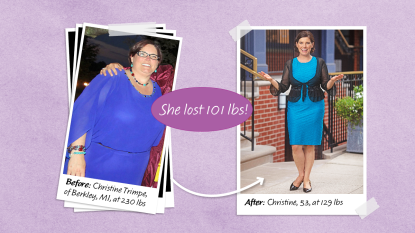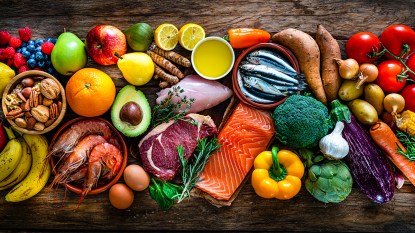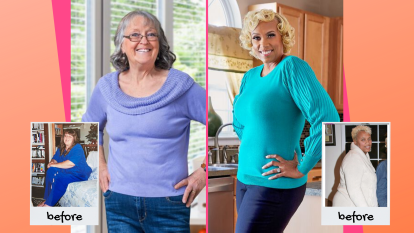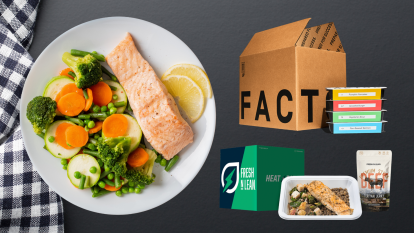This Small Swap Can Help You Melt More Pounds Than a Traditional Keto Diet
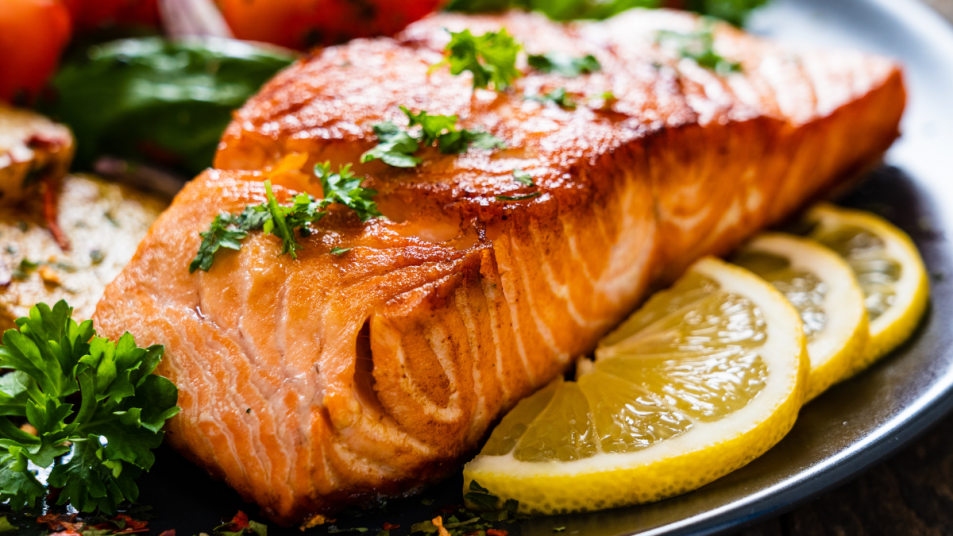
Chances are, you’ve tried (or at least considered!) the most searched-for, talked-about diet of the past few years: the keto diet. And there’s an equally good chance keto hasn’t worked for you. Maybe it was too complicated, too time-consuming or too expensive. Even the experts acknowledge how intimidating this way of eating can seem — and how frustrating it can be when you don’t see results.
That’s why Eric Westman, MD, founder of Duke University’s Keto Medicine Clinic, committed to creating a plan that would solve the problems with keto while still delivering results. “This is keto for people in the real world, with busy lives and budget constraints,” says Dr. Westman. “And it doesn’t require a total life overhaul to accommodate grocery shopping and meal prep.”
The secret to Dr. Westman’s keto plan: Replace the sugary, high-carb foods in your diet with protein, not fat. “There is a lot of emphasis on eating fat when you’re following a keto diet, but protein is even more important,” Dr. Westman asserts. That’s because protein replaces nutrients that sugar steals from the body. “To break down the food you eat and convert it into energy, your body uses vitamins and minerals,” he explains, “but sugar brings none of these to the party.”
Why eat more protein on the keto diet than fat?
The standard American diet is loaded with foods that age the body at the cellular level, report researchers at the University of Navarra in Spain. Their study showed that regularly eating sugary and processed foods shortens telomeres — tiny caps that protect DNA and slow the aging process. “The faster telomeres shorten, the faster cells age and the more vulnerable we are to problems associated with aging,” explains Elizabeth Blackburn, PhD, co-author of The Telomere Effect. In the Spanish study, those who ate more whole foods rich in protein were twice as likely to have longer telomeres than those who ate two servings of sugary or processed foods daily, an effect equivalent to extending life by five years.
When you eat sugar and processed carbs, your body has to draw on nutrients from its own reserves. Over time, this leaves you deficient in vitamins and minerals. Without these nutrients, the body thinks food is scarce, so it begins hoarding fat. To wit: Researchers from the International Food Policy Research Institute found that micronutrient-deficient women are 81 percent more likely to be overweight. And considering how much sugar is in the standard American diet, Dr. Westman says most of us are likely micronutrient deficient.
A protein-focused keto plan replaces depleted vitamins and minerals to release stored fat. The cornerstones of Dr. Westman’s plan are nutrient-dense foods like red meat and seafood that counteract the damage done to the body by years of eating sugar and carbs. “These foods are loaded with B vitamins, iron, zinc, selenium, and other critical vitamins and minerals,” he adds. “You can get these nutrients from other foods, but red meat and seafood provide them in exceptionally high amounts and in forms the body can absorb easily.” Once the body has these nutrients, it releases that stubborn stored fat.
Replacing sugar with protein also lowers insulin levels, which further fires up fat burn. “Insulin is like a policeman that keeps body fat locked in fat cells,” explains Dr. Westman. “When you lower your insulin levels, your body can start burning its own fat for fuel — which is what it’s there for! — and you’ll see your belly, thighs and other spots where you tend to store fat start to shrink.”
Even better, Dr. Westman’s twist on keto ends hunger. “When cells are being fed by stored fat, you have less need for fuel coming from the outside,” explains Dr. Westman. Research at the UK’s University of Surrey backs this up: in their study, people who ate plenty of protein saw a 68 percent increase in two key appetite-suppressing hormones. What’s more, you’ll stop dreaming about high-carb sweets. Low-carb expert Gary Taubes, author of The Case for Keto, adds, “When you switch to burning fat for fuel rather than carbs, your tastes will literally change.”
What does a keto diet packed with more protein look like?
“I’m going to share with you what I’ve learned in more than 20 years of helping people lose weight, reverse chronic illness and recover their zest for life,” promises Dr. Westman, whose protein-focused twist on the keto diet has helped scores of women lose weight. “The first and most important thing to know is that this is simple.”
How it works: For at least 30 days, you’ll keep your carb intake to 20 total grams or fewer each day. “The good news is that if you stick to eating my recommended foods, you’ll be exactly where you need to be — no need to keep count,” says Dr. Westman. And don’t worry that the plan is too difficult. “It’s funny when people ask if my lifestyle is ‘restrictive,’” says 63-year-old Virginia Dials, who lost 114 pounds. “Dr. Westman’s food list is extensive. I never feel deprived.” To slim down like Virginia, follow these to-do’s.
Get your fill of protein.
It’s the building block of Dr. Westman’s plan, but there’s no need to aim for a specific number of grams of protein every day. Just make protein — especially beef, pork, lamb, bison, venison, chicken, turkey, duck, eggs, fish, and shellfish — the focus every time you eat and stop eating when you’re comfortably full but not stuffed.
Add some veggies.
Every day, aim to eat up to cups cups of leafy greens (including arugula, cabbage, chard, kale, lettuce, radicchio, spinach, and watercress) and up to one cup of non-starchy veggies (including artichokes, asparagus, broccoli, Brussels sprouts, cauliflower, celery, cucumber, eggplant, green beans, mushrooms, okra, onions, peppers, snap peas, summer squash, tomatoes, and zucchini). Why not more? Because vegetables contain carbs, and this plan is like a prescription-strength version of a low-carb diet, explains Dr. Westman. “It is strict, but it guarantees that you will get results,” he says. “When you keep carbs low, you burn fat.”
Moderate fat intake.
While most keto diets take a more-is-better approach when it comes to fat, Dr. Westman’s plan calls for limiting added oils and fats, like cheese and dairy. “If you’re trying to lose body fat, you want to keep dietary fat to a minimum so that your body burns your existing fat,” he says. To get the benefits, enjoy up to 4 ounces of hard, aged cheese (like Asiago, Cheddar, Gouda, Gruyère, Parmesan, provolone, and Swiss) or soft, fresh cheese (goat cheese and cream cheese) per day as well as two tablespoons of mayonnaise, butter, ghee, oil, heavy cream, sour cream, or oil-based salad dressing.
Sidestep these foods.
Avoid nuts, seeds, and sugar and limit fruit to half a cup of berries each day. Nuts and seeds are higher in fat than they are in protein, so Dr. Westman counts them as a source of fat during the first 30 days of the plan. Not only that, they’re “trigger” foods that are hard to eat in moderation. “It’s a rare person who can open a bag of almonds, have a small handful and put the rest away,” says Dr. Westman. “For this reason, it’s best to avoid nuts and seeds at first.” While healthy, fruit contains large amounts of sugar and can slow progress, which is why he recommends sticking with berries at first.
Eat when you’re hungry.
The hormonal changes that occur when you follow Dr. Westman’s low-carb guidelines will regulate your appetite so you will feel satisfied with less food, promises Dr. Westman. In fact, you might even find yourself skipping meals because you’re just not hungry— and that’s okay! “The body can get energy from its supply of body fat between meals,” says Dr. Westman. By the same token, if you’re hungry between meals, a small, protein-rich snack won’t undo your progress.
What does a sample day look like?
BREAKFAST: Combine 4 eggs, 2 Tbs. milk, 4 Tbs. Parmesan, 4 oz. shredded spinach and 4 oz. ham. Pour into pan, cover and cook on low heat until center is set.
SNACK: Combine ¾ cup almond milk, 4 Tbs. chia seeds and 1 tsp. vanilla liquid stevia. Chill for at least 3 hrs. Top with mixed berries.
LUNCH: Load lettuce cups with baked chicken and a variety of non-starchy vegetables, like radishes, cucumbers, cauliflower and peppers.
DINNER: Top ½ cup of zucchini noodles with 5 oz. pan-seared meatballs. Toss with shredded Parmesan, roasted tomatoes, sliced olives and basil.
After one month on Dr. Westman’s plan, you can increase your carbohydrate intake. Dr. Westman suggests aiming for 50 grams of carbs or less each day. This means you can increase your portion sizes to four cups of greens and two cups of non-starchy veggies a day. And consider adding nuts and seeds (up to two ounces a day) and stone fruits (up to one medium piece of fresh fruit per day), as well as low-carb grain products like crispbreads, crackers, and wraps. To ensure you don’t regain lost weight, Dr. Westman suggests gradually increasing your carb intake by five to 10 grams per week.
This article originally appeared in our print magazine.


